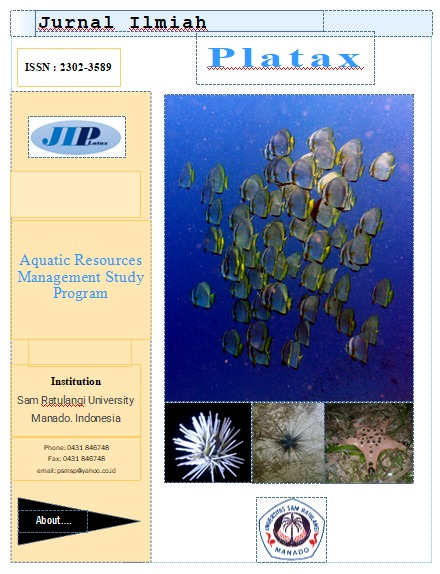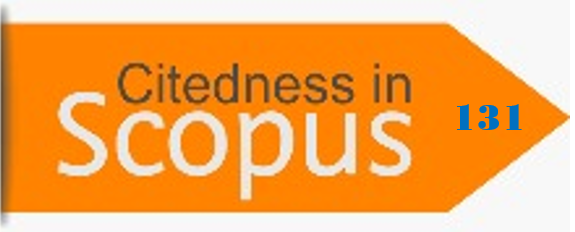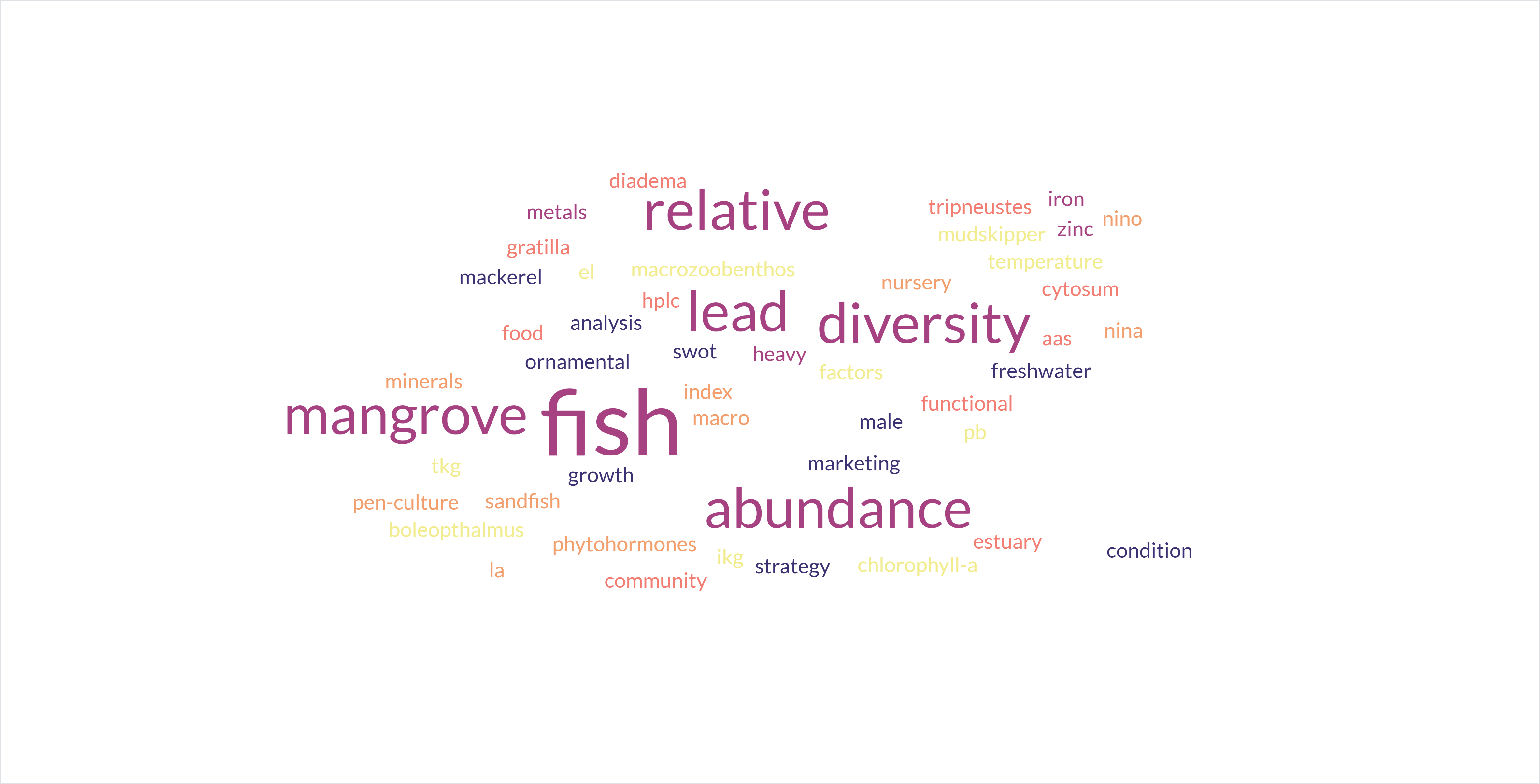Morphometry of Limpet, Patelloida heroldi (Dunker, 1861) on Exposed and Sheltered Intertidal Stony Shores at Magarizaki Beach, Amakusa, Japan
DOI:
https://doi.org/10.35800/jip.v12i2.58533Keywords:
Exposed intertidal stony shore, morphometry, Patelloida heroldi, shell, sheltered intertidal stony shoreAbstract
This study aims to determine the differences in shell dimensions (length, width, and height) of Patelloida heroldi between two locations: an exposed intertidal stony shore and a sheltered intertidal stony shore. The research was conducted at Magarizaki Beach, Tomioka Peninsula, Amakusa, Japan, over two months from March to April 2024. Sampling was conducted using 25 x 25 cm quadrats along a line transect. The results showed that the average shell size of P. herolda at the exposed shore was 7.52 mm in length, 5.57 mm in width, and 2.23 mm in height, while, at the sheltered shore was 5.34 mm in length, 4.10 mm in width, and 1.81 mm in height. The shell size of limpets living on the exposed shore was significantly larger than those on the sheltered shore (t-student, P < 0.05). This study suggests that the difference in limpet shell sizes between the two locations was not influenced by population density, but was likely affected by differences in food supply and sedimentation levels in the areas. The impacts of environmental factors and food supply on the growth of limpets at the two locations are necessary to study in the future.
Keywords: Exposed intertidal stony shore, morphometry, Patelloida heroldi, shell, sheltered intertidal stony shore
Abstrak
Tujuan penelitian ini adalah untuk menentukan perbedaan dimensi cangkang P. heroldi (panjang, lebar, dan tinggi) di antara dua lokasi berbeda, yaitu pantai berbatu intertidal terbuka dan pantai berbatu intertidal terlindung. Penelitian ini dilaksanakan di Pantai Magarizaki, Semenanjung Tomioka, Amakusa, Jepang selama 2 bulan, Maret-April 2024. Metode yang digunakan yaitu metode sampling kuadrat dengan menggunakan transek garis dan kuadrat yang berukuran 25 x 25 cm. Hasil penelitian menunjukkan bahwa rata-rata ukuran cangkang Patelloida heroldi di pantai berbatu terbuka, yaitu masing-masing panjang, lebar, dan tinggi cangkang sebesar 7,52 mm, 5,57 mm, dan 2,23 mm, sedangkan yang di pantai berbatu terlindung, yaitu masing-masing panjang, lebar, dan tinggi cangkang sebesar 5,34 mm, 4,10 mm, dan 1,81 mm. Ukuran cangkang limpet yang hidup di pantai berbatu terbuka lebih besar dibandingkan dengan yang hidup di pantai terlindung (t-student, P < 0,05). Penelitian ini memperlihatkan bahwa perbedaan ukuran cangkang limpet di kedua lokasi tidak dipengaruhi oleh faktor kepadatan, melainkan diduga dipengaruhi oleh perbedaan suplai makanan dan tingkat sedimentasi pada kedua area pantai intertidal berbatu yang terbuka dan terlindung. Pengaruh faktor-faktor lingkungan dan suplai makanan terhadap pertumbuhan limpet pada kedua lokasi perlu diteliti lebih lanjut.
Kata kunci: Cangkang, morfometri, pantai berbatu intertidal terbuka, pantai berbatu intertidal terlindung, Patelloida heroldi
References
Castejón, D., Hodgson, A., Nakano, T., Hawkins, S. J., & Andrade, C. A. P. (2024). True Limpets as Living Resources-Biology, Ecology, Exploitation and Sustainability. Frontiers in Marine Science, 11, 1364518 https://doi.org/10.3389/fmars.2024.1364518
Corder, G. W., & Foreman, D. I. (2014). Nonparametric Statistics: A step-by-step Approach. John Wiley & Sons. New Jersey. 288 halaman.
Desy, W., Ardyati, D. P. I., & Kusrini, K. (2022). Identifikasi Jenis-Jenis Gastropoda di Zona Intertidal Perairan Pantai Desa Lontoi Kecamatan Siompu Kabupaten Buton Selatan. Penalogik: Penelitian Biologi dan Kependidikan, 1(1), 25-44.
Firth, L. B. (2021). What Have Limpets Ever Done for Us?: On the Past and Present Provisioning and Cultural Services of Limpets. International Review of Environmental History, 7(2), 5-45. DOI:10.22459/IREH.07.02.2021.01
Fuji, A., Watanabe, H., Ogura, K., Noda, T., & Goshima, S. (1991). Abundance and Productivity of Microphytobenthos on a Rocky Shore in Southern Hokkaido. 北海道大學水産學部研究彙報, 42(4), 136-146.
Gajera, N., Vakani, B., & Kundu, R. (2022). Radular Morphology and Relationship Between Shell Size and Radula Size of Few Dominating Intertidal Gastropod Mollusks of Veraval Coast, Gujarat. Frontiers in Marine Science, 9, 657124.
Harayashiki, C.A.Y., Marquez, F., Cariou, E., Castro, I.B., (2020). Mollusk Shell Alterations Resulting from Coastal Contamination and Other Environmental Factors. Environ. Pollut. 265, 114881 https://doi.org/10.1016/j.envpol.2020.114881.
Harford, N., O’Connor, N., & Taylor, D. (2020). Impact Resistance of Limpet Shells: a Study of Local Adaptations. Applied Physics A, 126, 1-9.
Ha, H. J., Kim, H., Kwon, B. O., Khim, J. S., & Ha, H. K. (2020). Influence of Tidal Forcings on Microphytobenthic Resuspension Dynamics and Sediment Fluxes in a Disturbed Coastal Environment. Environment International, 139, 105743.
Jenkins, S. R., & Hartnoll, R. G. (2001). Food Supply, Grazing Activity and Growth Rate in the Limpet Patella vulgata: A Comparison Between Exposed and Sheltered Shores. Journal of Experimental Marine Biology and Ecology, 258(1), 123-139.
Karsten, U., Kuriyama, K., Hübener, T., & Woelfel, J. (2021). Benthic Diatoms on Sheltered Coastal Soft Bottoms (Baltic Sea)—Seasonal Community Production and Respiration. Journal of Marine Science and Engineering, 9(9), 949.
Kim, D. U., Kim, J., Bae, H., Kim, T., Lee, J., Lee, I. O., ... & Khim, J. S. (2024). Changes in Limpet Diet According to Habitat Type. Marine Pollution Bulletin, 207, 116826.
Landro, S.M., Teso, V., Arrighetti, F., (2021). The Panpulmonate Limpet Siphonaria lessonii Blainville, 1827 as a Sentinel of Contamination in Coastal Areas of Argentina. Ecol. Indicat. 121, 107075 https://doi.org/10.1016/j.ecolind.2020.107075.
Matos, A. S., Matthews-Cascon, H., & Chaparro, O. R. (2020). Morphometric Analysis of the Shell of the Intertidal Gastropod Echinolittorina Lineolata (d'Orbigny, 1840) at Different Latitudes Along the Brazilian Coast. Journal of the Marine Biological Association of the United Kingdom, 100(5), 725-731.
Mori, K & Tanaka, M. (1989). Intertidal Community Structures and Environmental Conditions of Exposed and Sheltered Rocky Shores in Amakusa, Japan. Publ. Amakusa Mar. Biol. Lab., 10, 41-64.
Murray, S. N., Ambrose, R., & Dethier, M. N. (2006). Monitoring Rocky Shores. Univ of California Press. California. 240 halaman.
Notman, G. M., McGill, R. A., Hawkins, S. J., & Burrows, M. T. (2016). Macroalgae Contribute to the Diet of Patella vulgata from Contrasting Conditions of Latitude and Wave Exposure in the UK. Marine Ecology Progress Series, 549, 113-123.
Paruntu, C. P., & Tokeshi, M. (2003). Variability in the Reproductive Characteristics of Local Populations of an Intertidal Gastropod, Nerita japonica (Dunker). Benthos Research, 58(1), 7-14.
Roring, I. Jordan. (2024). Struktur Komunitas Gastropoda di Daerah Intertidal Pantai Magarizaki, Amakusa, Jepang. Skripsi, 73 hal.
Rosenfeld, S., Marambio, J., Ojeda, J., Rodríguez, J. P., González-Wevar, C., Gerard, K., ... & Mansilla, A. (2018). Trophic Ecology of Two Co-Existing Sub-Antarctic Limpets of the Genus Nacella: Spatio-Temporal Variation in Food Availability and Diet Composition of Nacella magellanica and N. deaurata. ZooKeys, (738), 1.
Sempere-Valverde, J., Ostalé-Valriberas, E., Espinosa, F., & Márquez, F. (2024). Morphometric Variations of Two Patellid Limpets Between Artificial Breakwaters and Natural Reefs. Estuarine, Coastal and Shelf Science, 297, 108617 https://doi.org/10.1016/j.ecss.2024.108617
Takada, Y & Kikuchi, T. (1990). Mobile Molluscan Communities in Boulder Shores and the Comparison with Other Intertidal Habitats in Amakusa. Publ. Amakusa Mar. Biol. Lab., Kyushu Univ., 10, 145-168.
Takada, Y & Kikuchi, T . (1991). Seasonal and Vertical Variation of the Boulder Shore Fauna in Amakusa. Publ. Amakusa Mar. Biol. Lab., Kyushu Univ., 11, 1-17.
Takada, Y. (2007). Seasonal and Long-term Fluctuations in a Population of Patelloida heroldi (Mollusca: Gastropoda) on a Boulder Shore in Japan. Venus (Journal of the Malacological Society of Japan), 66(1-2), 85-97.
Vermeij, G. J. (2017). The Limpet Form in Gastropods: Evolution, Distribution, and Implications for the Comparative Study of History. Biological Journal of the Linnean Society, 120(1), 22-37 https://doi.org/10.1111/bij.12883
Vieira, E. A., & Bueno, M. (2019). Small Spatial Scale Effects of Wave Action Exposure on Morphological Traits of the Limpet Lottia subrugosa. Journal of the marine biological association of the United Kingdom, 99(6), 1309-1315.
Voronezhskaya E. E., Croll R. P. (2015). “Mollusca: Gastropoda,” in Structure and Evolution of Invertebrate Nervous Systems, eds A. Schmidt-Rhaesa, S. Harzsch, and G. Purschke (Oxford: Oxford University Press), 196–221.
Xu, T., Qi, L., Kong, L., & Li, Q. (2022). Mitogenomics Reveals Phylogenetic Relationships of Patellogastropoda (Mollusca, Gastropoda) and Dynamic Gene Rearrangements. Zoologica Scripta, 51(2), 147-160 https://doi.org/10.1111/zsc.12524
Downloads
Published
How to Cite
Issue
Section
License
Copyright (c) 2024 Jordan Iglesias Roring, Carolus Paruntu, Inneke Rumengan

This work is licensed under a Creative Commons Attribution-NonCommercial 4.0 International License.
COPYRIGHT
Authors who publish with this journal agree to the following terms:
Authors hold their copyright and grant this journal the privilege of first publication, with the work simultaneously licensed under a Creative Commons Attribution License that permits others to impart the work with an acknowledgment of the work's origin and initial publication by this journal.
Authors can enter into separate or additional contractual arrangements for the non-exclusive distribution of the journal's published version of the work (for example, post it to an institutional repository or publish it in a book), with an acknowledgment of its underlying publication in this journal.
Authors are permitted and encouraged to post their work online (for example, in institutional repositories or on their website) as it can lead to productive exchanges, as well as earlier and greater citation of the published work (See The Effect of Open Access).




















